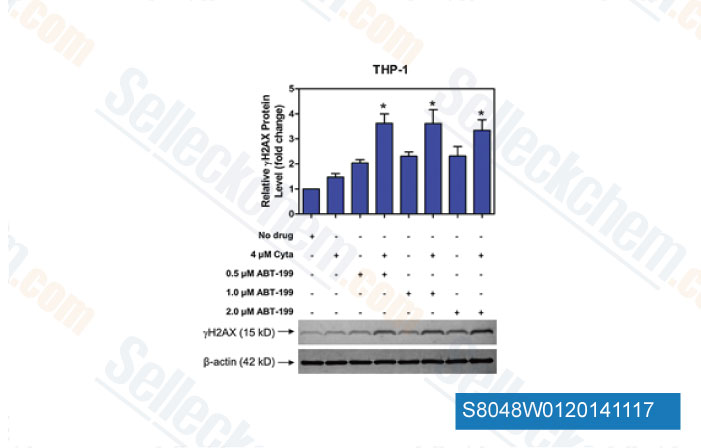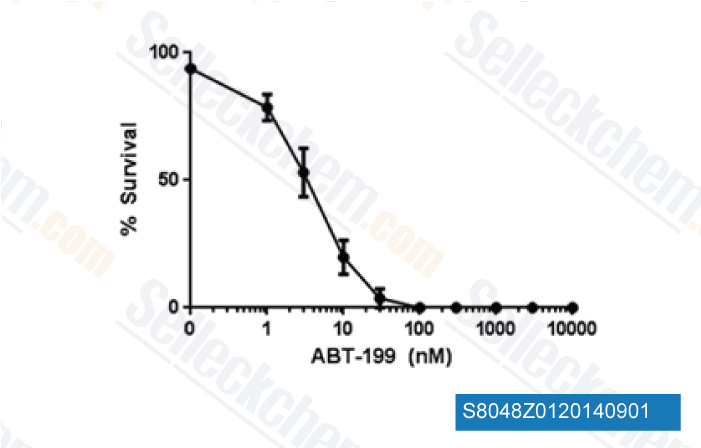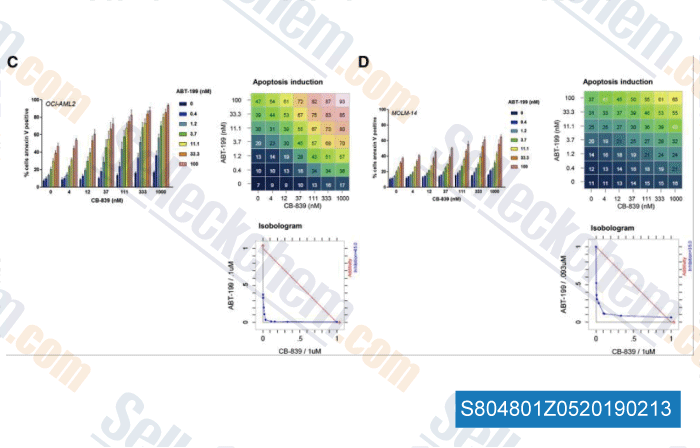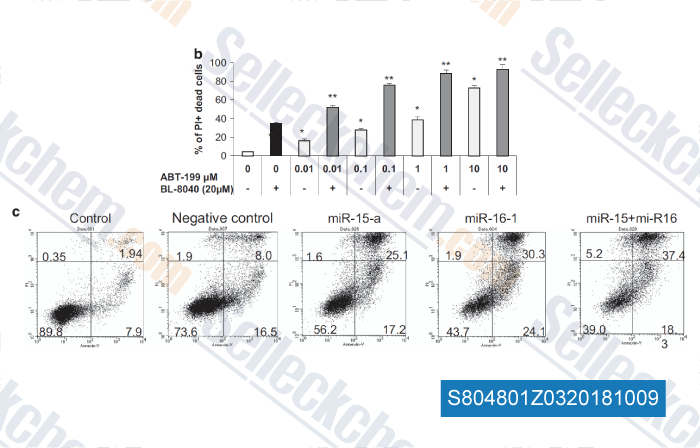|
Toll Free: (877) 796-6397 -- USA and Canada only -- |
Fax: +1-832-582-8590 Orders: +1-832-582-8158 |
Tech Support: +1-832-582-8158 Ext:3 Please provide your Order Number in the email. |
Technical Data
| Formula | C45H50ClN7O7S |
|||
| Molecular Weight | 868.44 | CAS No. | 1257044-40-8 | |
| Solubility (25°C)* | In vitro | DMSO | 100 mg/mL (115.14 mM) | |
| Water | Insoluble | |||
| Ethanol | Insoluble | |||
|
* <1 mg/ml means slightly soluble or insoluble. * Please note that Selleck tests the solubility of all compounds in-house, and the actual solubility may differ slightly from published values. This is normal and is due to slight batch-to-batch variations. * Room temperature shipping (Stability testing shows this product can be shipped without any cooling measures.) |
||||
Preparing Stock Solutions
Biological Activity
| Description | Venetoclax (ABT-199, GDC-0199) is a Bcl-2-selective inhibitor with Ki of <0.01 nM in cell-free assays, >4800-fold more selective versus Bcl-xL and Bcl-w, and no activity to Mcl-1. Venetoclax is reported to induce cell growth suppression, apoptosis, cell cycle arrest, and autophagy in triple negative breast cancer MDA-MB-231 cells. Phase 3. | ||
|---|---|---|---|
| Targets |
|
||
| In vitro | ABT-199 shows less sensitivity to Bcl-xL, Mcl-1 and Bcl-w with Ki of 48 nM, > 444 nM and 245 nM, respectively. ABT-199 potently inhibits FL5.12-Bcl-2 cells, RS4;11 cells with EC50 of 4 nM and 8 nM, while shows low activity against FL5.12-Bcl-xL cells with EC50 of 261 nM. ABT-199 induces a rapid apoptosis in RS4;11 cells with cytochrome c release, caspase activation, the externalization of phosphatidylserine and the accumulation of sub-G0/G1 DNA. Quantitative immunoblotting reveals that sensitivity to ABT-199 correlated strongly with the expression of Bcl-2, including NHL, DLBCL, MCL, AML and ALL cell lines. ABT-199 also induces apoptosis in CLL with an average EC50 of 3.0 nM. [1] | ||
| In vivo | ABT-199 (100 mg/kg) causes a maximal tumor growth inhibition of 95% and tumor growth delay of 152% in RS4;11 xenografts. ABT-199 also inhibits xenograft growth (DoHH2, Granta-519) as a single agent or in combination with SDX-105 and other agents. [1] | ||
| Features | Re-engineered version of ABT-263 (Navitoclax). |
Protocol (from reference)
| Kinase Assay:[1] |
|
|---|---|
| Cell Assay:[1] |
|
| Animal Study:[1] |
|
Customer Product Validation

-
Data from [Data independently produced by Mol Oncol, 2014, 10.1016/j.molonc.2014.09.008]

-
Data from [J Biol Chem, 2014, 289(23), 16190-9]

-
Data from [Data independently produced by , , Blood, 2015, 126(11):1346-56]

-
Data from [Data independently produced by , , Leukemia, 2017, 31(11):2336-2346]
Selleck's Venetoclax (ABT-199) has been cited by 664 publications
| PIM2 inhibition promotes MCL1 dependency in plasma cells involving integrated stress response-driven NOXA expression [ Nat Commun, 2025, 16(1):256] | PubMed: 39747141 |
| Oncogenic role of RARG rearrangements in acute myeloid leukemia resembling acute promyelocytic leukemia [ Nat Commun, 2025, 16(1):617] | PubMed: 39805831 |
| Microbiota-derived urolithin A in monoclonal gammopathies and multiple myeloma therapy [ Microbiome, 2025, 13(1):56] | PubMed: 40022244 |
| A patient-derived T cell lymphoma biorepository uncovers pathogenetic mechanisms and host-related therapeutic vulnerabilities [ Cell Rep Med, 2025, S2666-3791(25)00102-8] | PubMed: 40147445 |
| LP-118 is a novel B-cell lymphoma 2 / extra-large inhibitor that demonstrates efficacy in models of venetoclaxresistant chronic lymphocytic leukemia [ Haematologica, 2025, 110(1):78-91] | PubMed: 39113656 |
| Oncogenic and microenvironmental signals drive cell type specific apoptosis resistance in juvenile myelomonocytic leukemia [ Cell Death Dis, 2025, 16(1):165] | PubMed: 40057493 |
| Mitochondrial priming and response to BH3 mimetics in "one-two punch" senogenic-senolytic strategies [ Cell Death Discov, 2025, 11(1):91] | PubMed: 40055336 |
| HDAC10 and its implications in Sézary syndrome pathogenesis [ Front Cell Dev Biol, 2025, 13:1480192] | PubMed: 39958888 |
| A novel FOXM1-BCL2A1 axis determines unfavorable response to venetoclax in AML [ J Biol Chem, 2025, 301(3):108240] | PubMed: 39880086 |
| Differential regulation of BAX and BAK apoptotic activity revealed by small molecules [ Sci Adv, 2025, 11(10):eadr8146] | PubMed: 40043112 |
RETURN POLICY
Selleck Chemical’s Unconditional Return Policy ensures a smooth online shopping experience for our customers. If you are in any way unsatisfied with your purchase, you may return any item(s) within 7 days of receiving it. In the event of product quality issues, either protocol related or product related problems, you may return any item(s) within 365 days from the original purchase date. Please follow the instructions below when returning products.
SHIPPING AND STORAGE
Selleck products are transported at room temperature. If you receive the product at room temperature, please rest assured, the Selleck Quality Inspection Department has conducted experiments to verify that the normal temperature placement of one month will not affect the biological activity of powder products. After collecting, please store the product according to the requirements described in the datasheet. Most Selleck products are stable under the recommended conditions.
NOT FOR HUMAN, VETERINARY DIAGNOSTIC OR THERAPEUTIC USE.
